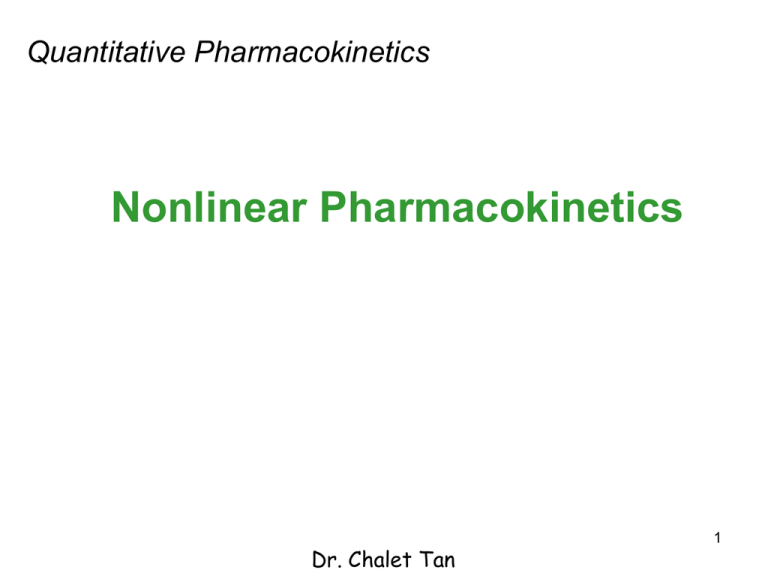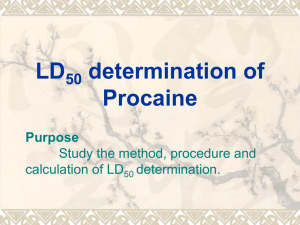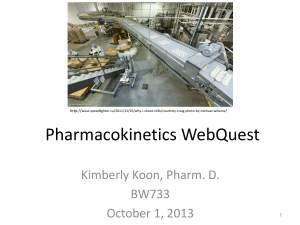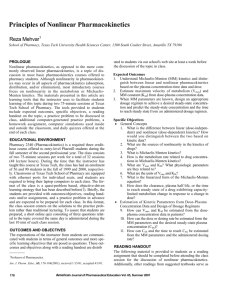File
advertisement

Quantitative Pharmacokinetics Nonlinear Pharmacokinetics Dr. Chalet Tan 1 Learning Objectives profiles of nonlinear kinetics sources and effects of dose dependency on ADME Michaelis-Menten equation and parameters (Vmax, Km) for capacity-limited metabolism 2 Case Study An epileptic patient who has not responded to phenytoin after 2 weeks on 300 mg/day is observed to have a plasma concentration of 4 mg/ml. Twenty days after the daily dose is subsequently increased to 500 mg/day, the patient develops severe toxicities. The plasma concentrations of phenotoin is now 36 mg/L. Review of Linear Pharmacokinetics ADME all obey first-order kinetics Pharmacokinetic parameters, e.g. elimination half-life (t1/2), the elimination rate constant (k), the apparent volume of distribution (V) and the clearance (CL) remain constant. Plasma drug concentration at a given time and AUC are directly proportional to the dose. Concentrations of drug in plasma and tissues are below protein binding saturation , i.e. fu and fuT remain constant. 4 Review of Linear Pharmacokinetics i.v. bolus i.v. bolus normalized 10 mM by dose 1 mM 1 mg 1h 10 mg time Log C Log C 100 mM 100 mg 1 mg 1h time Drug plasma concentrations are proportional to the dose. Drug plasma concentration-time profiles are superimposable when normalized to the dose. Review of Linear Pharmacokinetics p. o. 2.5 mM normalized 0.5 mM by dose 25 mg 0.1 mM 1 mg tmax time 5 mg Log C Log C p. o. 0.1 mM 1 mg tmax time Drug plasma concentrations are proportional to the dose. tmax remains unchanged. Drug plasma concentration-time profiles are superimposable when normalized to the dose. Cp or AUC VD or CL or t1/2 Review of Linear Pharmacokinetics Dose Dose 7 Nonlinear Pharmacokinetics i.v. bolus i.v. bolus 800 mM normalized 20 mM 10 mg 1 mM 1 mg 1h time by dose Log C Log C 100 mg 8 mM 2 mM 1 mM 1 mg 10 mg 1h 100 mg time Drug plasma concentrations are not proportional to the dose. Drug plasma concentration-time profiles are not superimposable 8 when normalized to the dose. Nonlinear Pharmacokinetics p. o. p. o. 5 mM normalized 1 mM by dose 100 mg 10 mg 1 mg Log C Log C 10 mM 1 mM 0.5 mM 0.1 mM 1 mg 10 mg 100 mg time time Drug plasma concentrations are not proportional to the dose. tmax may or may not change. Drug plasma concentrations are not superimposable when normalized to the dose. F, V, CL or t1/2 Cp or AUC Nonlinear Pharmacokinetics linear Dose linear Dose 10 Common Sources for Nonlinear Pharmacokinetics 11 Linear vs. Nonlinear Pharmacokinetics Linear Nonlinear (dose-independent) (dose-dependent) ADME all obey first-order kinetics. at least one of the ADME processes is saturable. PK parameters (CL, V, F, Ka, ≥1 PK parameters are dosedependent. and t1/2) are constant. AUC is directly proportional to the dose. AUC is disproportional to the dose. Concentration vs. time profile is superimposable for all doses. Concentration vs. time profile is not superimposable for different doses. 12 Most Common Sources for Nonlinear Pharmacokinetics Capacity-limited oral absorption (F) Capacity-limited metabolism (CLH ) Saturable protein binding (CLH, CLR, V ) Capacity-limited excretion (CLR ) 13 Capacity-Limited Oral Absorption (F) limited dissolution/solubility as the oral dose increases saturable transport across the intestinal mucosa as the oral dose increases saturable first-pass metabolism in the intestinal epithelium (gut wall) and/or liver as the oral dose increases 14 e. g. - limited dissolution/solubility in the GI tract normalized to the dose - Griseofulvin is poorly water-soluble (10 mg/L). - Less proportion of the drug is being dissolved and absorbed with the higher dose. - F decreases as the dose increases. - tmax remains the same. 15 e. g. - Saturable transport across the intestinal epithelium 375 mg 750 mg 1500 mg 3000 mg - Amoxicillin is actively transported by peptide transporter in the small intestine. - The active transport becomes saturated as the dose increases. - F decreases as the dose increases. - tmax remains the same. 16 e. g. - Saturable first-pass metabolism - Nicardipine is metabolized by CYP3A4 in the intestinal epithelium and hepatocytes. - First-pass metabolism is saturated as the dose increases. - F increases as the dose increases. 17 e. g. - Saturable first-pass metabolism 18 Saturable Drug-Plasma Protein binding (CL,V) Drug-plasma protein binding is saturable The saturation drug concentrations for binding with plasma albumin and a1-acid glycoprotein are ~ 600 mM and 15 mM, respectively. May increase CLH and/or CLR May increase V May be difficult to identify due to effect on both V and CL 19 - saturable plasma protein binding - AUC and Cp of trandolaprilat do not increase proportionally with D; Cp does not accumulate with multiple doses. - As the dose increases, binding to ACE (angiotensin-converting enzyme) in plasma is saturated. -Trandolaprilat is elminated by glomerular filtration 2 g/day CLR= fu GFR - As fu increases with 20 higher Cp, CLR increases. Capacity-Limited Excretion (CLR) Active secretion and active reabsorption are saturable processes. Saturated tubular secretion decreases CLR Saturated tubular reabsorption increases CLR CLR = fu GFR + (CLsecretion – CLreabsoption) rateof tubular secretion CLsecretion Cp rateof reabsorption CLreabsorption Cp 21 e. g. - capacity-limited renal excretion CLinulin = GFR When concentration is about lower than mg/L, it could be linear. Since clearance linear. But once it gets above 7, the clearance rises, which makes it non-line p.o. 30-80 mg When Cp above 10 mg/L starts to saturate renal reabs of Vit C. i.v. 1.5-6 g - Vitamin C is reabsorbed from urine by active transporter. - Tubular reabsorption becomes saturated as Cp increases, i.e. as Cp increases, CLreabsorption (= Ratereabsorption /Cp) decreases. - ClR (=fu GFR –CLreabsorption) approaches GFR (fu=1) as Cp increases. 22 Capacity-Limited Metabolism (CLH ,F) Enzymatic reactions are saturable. Vmax[ S ] v K m [S ] Saturated hepatic metabolism decreases CLH. Saturated first-pass metabolism increases F. 23 e. g. - capacity-limited metabolism - Phenytoin is eliminated by hepatic metabolism only. - As the dosing rate increases, Cp increases disproportionally. - As the dosing rate increases, hepatic metabolism is saturated and CL decreases. FD - As the dosing rate increases, it takes longer time to reach steady state. CL Css 24 Michaelis-Menten Kinetics Applied to Metabolism k 1 k 2 [ E ] [ S ] [ ES] [ E ] [ P] k 1 [ E ][S ] k1 Km [ ES] k1 Vmax [ ET ]k2 Vmax[ S ] v K m [S ] n: rate of metabolism Vmax : maximum rate of metabolism Km : Michaelis constant, disassociation constant of ES [S]: drug concentration 25 Michaelis-Menten kinetics Rate of Metabolism is NOT ALWAYS proportional to drug concentrations n Vmax[ S ] v K m [S ] - When [S] = Km , n=1/2 nmax Zero order Non linear Km is the drug concentration at which half of the active sites on enzymes are occupied. Vmax[ S ] - When [S] <<< Km , v Km - When [S] >>> Km , v Vmax First order Km [S] 26 Michaelis-Menten Kinetics Applied to CLM Rate of elimination = CL x Cp rateof elimination CL Cp Rate of metabolic elimination = VmaxCp v K m Cp Vmax metabolicclearance(CLM ) K m Cp 27 Michaelis-Menten Kinetics Applied to Metabolism VmaxCp v CLM Cp K m Cp When Cp << Km , linear PK zero-order nmax n Vmax CLM K m Cp Vmax CLM Km non-linear VmaxCp v CLM Cp Km When Cp >> Km , v V max first-order Km [Drug] CLM 0 28 Linear vs. Saturable Metabolism nonlinear linear Vmax CLM K m Cp CL CL Clearance is independent of Cp Cp Cp 29 Michaelis-Menten Kinetics Applied to Metabolism Rate of metabolic elimination = Vmax[ S ] v K m [S ] At the steady-state following multiple dosing , FD V max Css Rate of metabolic eliminatio n Dosing Rate ( ) Km Css V max Metabolic clearance (CLM ) Km Css Km D / CSS V max / F D / D (V max/ F ) Css Km Css 30 Linear vs. Saturable Metabolism nonlinear CSS CSS linear D/ D/ FD CL Css 31 Most Common Sources for Nonlinear Pharmacokinetics Capacity-limited oral absorption (F) Capacity-limited metabolism (CLH ) Saturable protein binding (CLH, CLR, V ) Capacity-limited excretion (CLR ) 32 Case Study At a daily intake of 75 mg of ascorbic acid (vitamin C), the steady-state plasma concentration is 9 mg/L, whereas at a daily dose of 10,000 mg, the steady-state concentration is about 19 mg/L in a healthy volunteer. The renal clearance of ascorbic acid is less than 0.5 ml/min at the plasma concentration of 9 mg/ml, whereas the renal clearance is 21 ml/min at 19 mg/L. Vitamin is absorbed by passive facilitated diffusion in the small intestine, and undergoes tubular reabsorption in the kidney. Maintenance Dose Selection for Phenytoin - Phenytoin is eliminated by hepatic metabolism (CYP2C9) only. -Variability in Vmax and Km values in patients causes a wide range in the effective doses needed to achieve therapeutic levels. therapeutic range= 10-20 mg/ml = 10-20 mg/L 34 Michaelis-Menten Kinetics Applied to Metabolism Rate of metabolic elimination = Vmax[ S ] v K m [S ] At the steady-state following multiple dosing , FD V max Css Rate of metabolic eliminatio n Dosing Rate ( ) Km Css V max Metabolic clearance (CLM ) Km Css Km D / CSS V max / F D / D (V max/ F ) Css Km Css 35 How to Obtain Vmax/F and Km D (V max/ F ) Css Km Css y= m x - b -Km * * Slope = Vmax /F Slope = m = y2-y1 x2-x1 y Css (V max / F ) Css Css Km D / Css / Dose rate -b * x * The Direct Linear Plot Vmax/F dosing rate 2 dosing rate 1 -C2 -C1 Biochem J, 139:715-20 (1974) Km 37 Maintenance Dose Selection for Phenytoin A patient has been taking phenytoin (PHE) 150 mg b.i.d for 4 months. His plasma levels of PHE averaged 5 mg/L on this dose. Adjustment in dose to 250 mg b.i.d eventually led to a new plateau level of 20 mg/L. Assuming true steady state, strict patient compliance and that the measured plasma concentrations represent average levels over the dosing interval. a) use a graphical method to estimate the patient's operative Vmax/F and Km values; b) estimate a daily dose which should provide a steady-state plasma level of 12 mg/L. 38 Drug-Protein Binding Nonlinear Pharmacokinetics fu V Vp VT fu T Rate of metabolic elimination = CLM Clearance Concepts EH V max Km Cp Rat e of Met abolism Dosing Rat e ( fuCL int QH fuCL int D (V Css (V fu CL int CL H Q H EH Q H ( ) Q H fuCL int fu CL int QH Q H fu CL int Q H fu CL int Css F 1 E 1 VmaxCp K m Cp FD ) V max Css Km Css / F ) Css Km Css max / F ) Css Km D / max * * Slope=Vmax /F Css / Dose rate Vmax/F -Km dosing rate 2 dosing rate 1 -C2 -C1 Km 40 41 42 43 44









